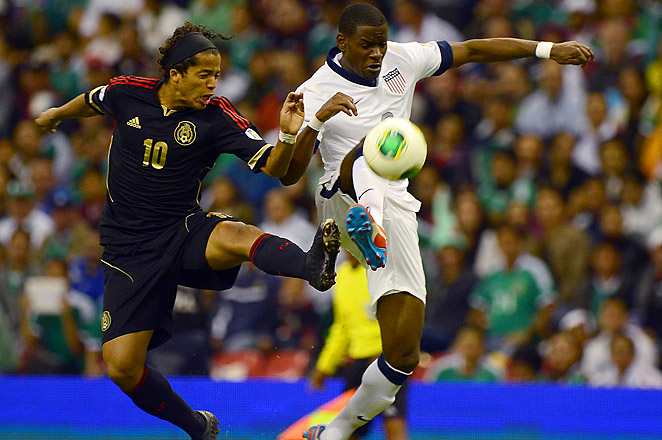Four Thoughts: U.S. earns hard-fought point at Estadio Azteca

The U.S. now sits at second place in the competitive Hexagonal, with four points after three matches.
ALFREDO ESTRELLA/Getty Images
MEXICO CITY -- Four thoughts after the U.S.'s 0-0 tie against Mexico in Tuesday's World Cup qualifier:
? The U.S. got a Golden Point in the vaunted Estadio Azteca. Sixteen years after the U.S. got its only competitive point against Mexico in the history of this stadium, another group of committed Yanks pulled off the same feat, earning a deserved tie in the Thunderdome that used to be the U.S.'s house of horrors. Mexico was a remarkable 68-1-6 in World Cup qualifiers in the history of the Azteca, but El Tri hasn't played well here lately, and the U.S. weathered a storm of Mexican attacks down the right side (targeting left back DaMarcus Beasley) and kept its mettle in the most difficult of road environments. It's amazing how much can change in a week. Just a few days ago, coach Jurgen Klinsmann was thought to be losing the U.S. locker room. But four points and two games later, the U.S. has turned things around, rising to second place in the Hexagonal?and that's with two of the hardest road games (at Mexico and Honduras) out of the way. It's still early with seven qualifiers to go, but the U.S. is in good shape now in World Cup qualifying.
WAHL: Estadio Azteca losing its mystique
? Omar González became a man for the U.S. on Tuesday. Making just his third start under Jurgen Klinsmann, the 24-year-old González was a monster at center back for the U.S., especially in the second half when he was everywhere putting out fires. González was the MLS Defender of the Year two years ago and the MVP of the 2012 MLS Cup final, but he struggled against Honduras last month. That was hardly the case against Mexico, when he used his 6'5" height to clear crosses in the box, and used his positioning and underrated foot speed to keep up with the ever-dangerous Javier Hernández. What's more, González worked well in tandem with central partner Matt Besler (making just his second U.S. start), keeping narrow when they had to and spreading out when necessary. If González could have this kind of performance in the Azteca, then he can do it anywhere in the world.
CREDITOR: Beasley still has value
? Who knew Beasley would play such a big role in the last two games? After being a somewhat surprising call-up to the roster, Beasley was a central figure as a left back in the second straight qualifier for the United States. Against Costa Rica, Beasley was able to push upfield more in the absence of an attacking wing threat, but against Mexico he was targeted mercilessly from the start. El Tri kept sending balls to right wing Javier Aquino, who worked Beasley hard, earning a yellow card in the eighth minute and going after him time and again. But U.S. left mid Hérculez Gómez and center back Besler did a good enough job providing cover for Beasley and keeping Mexico from getting the goal it needed. The U.S. bent and bent and bent, but never broke.
WAHL: Why you should be watching Liga MX
? Mexico has some issues. There will be complaints from the Mexican end that two penalties were missed, but that doesn't make up for the fact that El Tri is struggling in the Hex, having failed to win any of its first three games, all of them ties. When you drop four points at home against Jamaica and the U.S., that's just unacceptable to demanding Mexican fans who grew restless with their team as the game progressed on Tuesday. Coach Chepo de la Torre should have earned enough credit that he won't be in danger of losing his job, but you never know with the Mexican federation, which has fired previous coaches for less.
Come back to SI.com later for my column after the postgame press access ...





